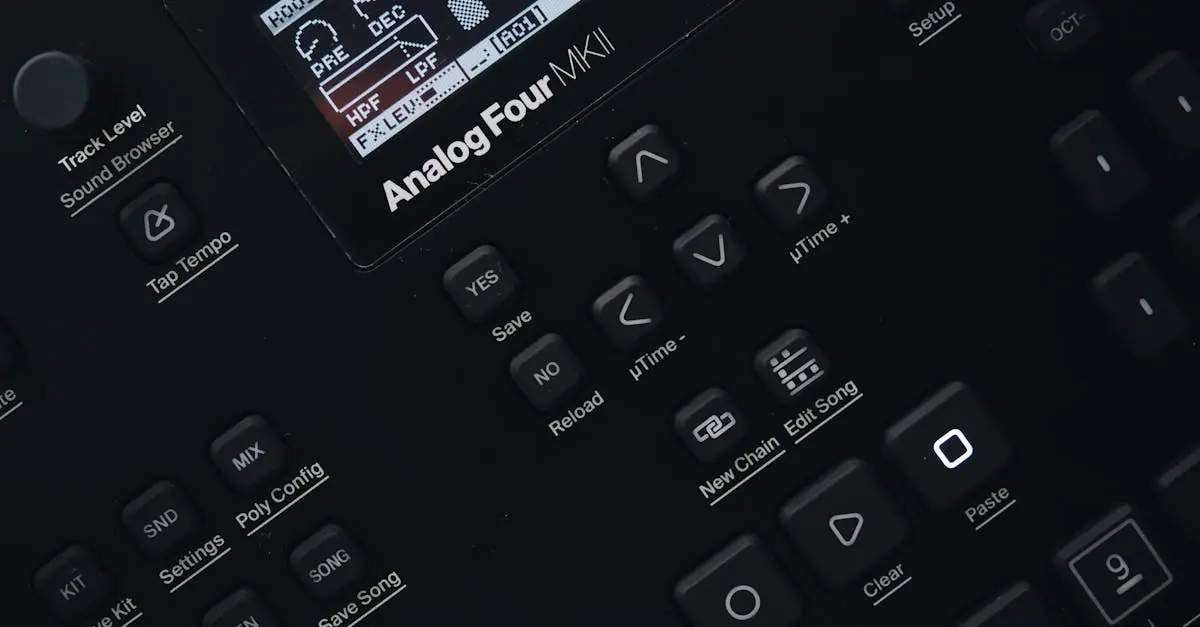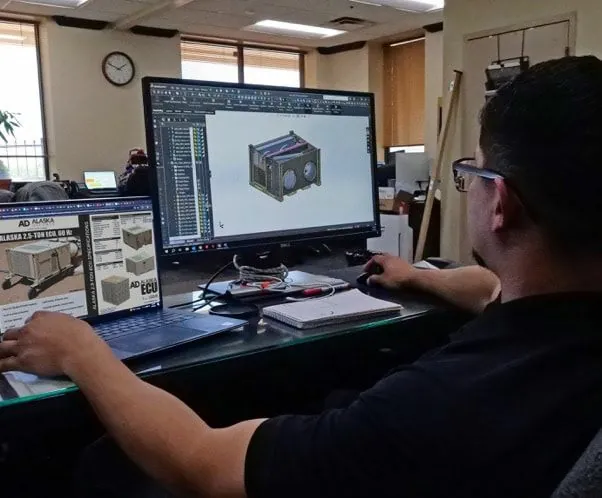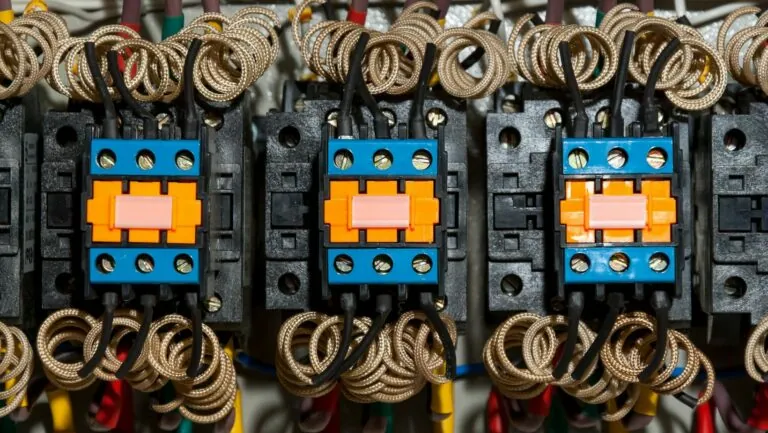Imagine diving into a sonic wonderland where every twist and turn of a knob unleashes a new auditory adventure. Modular synthesizer hardware isn’t just a tool; it’s a playground for the creatively curious. Whether you’re a seasoned sound wizard or just starting to dip your toes into the world of music production, these customizable systems offer endless possibilities to shape and manipulate sound like never before.
Table of Contents
ToggleOverview of Modular Synthesizer Hardware
Modular synthesizer hardware consists of individual modules that connect through patch cables, allowing users to construct personalized sound processing systems. Each module serves a specific function, such as oscillators, filters, or envelope generators, providing flexibility in sound design. Users can mix and match modules based on their creative needs, producing unique audio outputs during each session.
A typical setup includes a power supply, case, and various sound-generating and processing modules. Power supplies often provide the necessary voltage for modules, while cases offer physical space and organization. Functions of common modules include sound generation, modulation, and effects routing.
Patch cables connect modules, facilitating signal flow and encouraging experimentation. The process of patching can lead to unexpected sound results, making it an essential part of the modular experience. Many musicians appreciate this hands-on approach, as it fosters creativity and spontaneity in performances.
Popular brands in the modular synthesizer market include Make Noise, Intellijel, and Doepfer. These companies manufacture high-quality modules known for their reliability and innovative designs. Customization of modular setups through various modules allows users to achieve specific sonic characteristics, whether for live performances or studio recordings.
Sound exploration using modular synthesizers often emphasizes real-time manipulation. This dynamic interaction can produce evolving soundscapes, enhancing the overall creative process. Many musicians enjoy the tactile nature of these systems, providing a stark contrast to fixed-architecture synthesizers. Exploratory sound design and spontaneous musical ideas emerge naturally from modular synthesizer hardware.
Key Components of Modular Synthesizers
Modular synthesizers consist of several essential components that collectively shape the sound. Each component plays a critical role in the overall functionality and creativity of the system.
Oscillators
Oscillators generate the fundamental waveforms used in sound synthesis. Various types of oscillators, including sine, square, and sawtooth, produce distinct tones. Users can modulate these waveforms for added complexity. Many oscillators allow frequency control for pitch adjustment, while others offer features like sync capabilities. The choice of oscillator directly influences the timbre and character of the resulting sound.
Filters
Filters modify the frequency spectrum of audio signals. They can remove specific frequency ranges, shaping the overall sound. Common filter types include low-pass, high-pass, band-pass, and notch filters, each serving unique purposes. Filtering techniques allow users to sculpt tonal qualities, creating rich textures and enhancing clarity. Sound designers often apply resonance settings to emphasize certain frequencies, further altering the output’s character.
Envelopes and LFOs
Envelopes control sound dynamics over time, affecting parameters such as amplitude and filter cut-off. Generating contours like attack, decay, sustain, and release defines how sounds evolve. Low-Frequency Oscillators (LFOs) introduce modulation to various parameters, creating movement within sounds. Users can apply LFOs to pitch, filter, or amplitude for dynamic effects. By combining envelopes and LFOs, musicians infuse their sounds with depth and variability, resulting in expressive performances.
Benefits of Using Modular Synthesizer Hardware
Modular synthesizer hardware offers several benefits, making it a sought-after choice for musicians and sound designers. Users appreciate the ability to create customized setups tailored to their unique needs and preferences.
Flexibility and Customization
Flexibility stands at the forefront of modular synthesizer systems. Users can choose from a wide array of modules, enabling them to build configurations that suit specific musical styles or experimentation. Each module serves a distinct purpose, whether oscillators create foundational sounds or filters sculpt frequencies. Musicians can add or remove components based on their creative process, fostering a playful and adaptive environment. This individual approach encourages personal expression and the exploration of new sonic territories. Customization reinforces the idea that no two setups have to resemble one another, allowing for a unique experience every time.
Sound Design Capabilities
Sound design capabilities shine with modular synthesizers. Musicians harness the power of various modules to create rich, complex soundscapes. Oscillators produce different waveforms that can be shaped, modulated, and layered, adding depth to compositions. Filters enhance sonic clarity and tonal variations, while envelopes offer dynamic control throughout sound evolution. Low-Frequency Oscillators (LFOs) introduce movement and modulation, transforming static sounds into dynamic performances. These capabilities grant sound designers the freedom to craft innovative audio experiences. Each module interacts with others, creating limitless possibilities for sound manipulation.
Popular Modular Synthesizer Brands
The modular synthesizer market features several brands renowned for their innovation and quality. Each brand contributes unique characteristics that appeal to different users.
Make Noise
Make Noise stands out with its innovative approach to modular synthesizers. Known for high-quality modules like the Maths and the Telharmonic, these devices encourage creative sound manipulation. The design emphasizes hands-on control, making it especially suitable for performers seeking spontaneity. Make Noise products integrate versatile functionality, appealing to both novice and experienced users. Their modules often feature unique signal paths, allowing for complex interactions among components. Musicians appreciate the tactile response of these devices, leading to engaging performances.
Intellijel
Intellijel has gained recognition for its meticulously crafted modular modules that prioritize user experience. Their range includes the Atlantis, a powerful synth voice, and the Rubicon, known for rich waveform generation. Each module reflects thoughtful design, incorporating features that enhance usability. Intellijel’s offerings often include clear visual indications, promoting ease of navigation. Its focus on compatibility with other gear allows seamless integration into existing setups. Musicians frequently choose Intellijel for their reliability and excellent build quality, ensuring long-lasting performance.
Doepfer
Doepfer has played an influential role in popularizing modular synthesizers since its inception. Their A-100 system consists of a wide variety of modules that cater to diverse needs, from basic oscillators to complex sequencers. Versions of these modules offer flexibility and straightforward functionality, making them approachable for beginners. Doepfer also emphasizes affordability without sacrificing quality, which attracts many users. The extensive selection ensures musicians find modules suited for all types of sound design projects. Established as a benchmark in the industry, Doepfer’s contribution remains significant for aspiring synthesists.
Best Practices for Building a Modular Synthesizer
Establishing a modular synthesizer setup involves strategic planning and thoughtful module selection. Begin by identifying the desired sound palette and functionalities. Prioritize modules that complement each other, ensuring the setup addresses specific sound design goals.
Select a power supply that provides ample headroom for future expansions. Reliable power systems enhance stability and prevent unwanted noise in audio outputs. A suitable case facilitates organization, making navigation during live performances seamless.
Incorporate a mix of sound-generating and processing modules to create a versatile system. Oscillators, filters, and envelope generators serve foundational roles in shaping sound. Users benefit from experimenting with diverse module types. For instance, LFOs add rhythmic movement, enhancing dynamic textures in compositions.
Maintain an open approach to patching. Experimenting with different connections fosters unique sound explorations. Users often discover unexpected results through spontaneous patching routes. Creating a patchbook can document successful configurations, helping streamline future sessions.
Regularly update the setup based on evolving musical taste and needs. New modules frequently emerge, offering innovative functions that may expand creative horizons. Evaluating and rearranging current modules can breathe new life into an existing setup.
Collaboration can yield fresh perspectives. Engaging with fellow musicians may inspire new ideas and techniques. Discussing module choices and strategies often leads to deeper understanding and efficient utilization of the gear.
Adopting a patient mindset is crucial during the creative process. Sound design intricacies reveal themselves over time, inviting users to explore thoroughly. Passionate experimentation rewards musicians with rich, expressive soundscapes, ultimately refining their artistic voice.
Conclusion
Modular synthesizer hardware stands as a powerful ally for musicians seeking to push the boundaries of sound. Its unique ability to adapt and evolve makes it an essential tool for both seasoned artists and newcomers alike. With the right modules and a willingness to experiment, users can unlock a world of sonic possibilities that reflect their individual creativity.
Building a custom setup encourages a deeper understanding of sound design and performance techniques. As musicians continue to explore and refine their modular systems, they not only enhance their skills but also contribute to a vibrant and ever-evolving music community. Embracing the journey of sound exploration can lead to truly transformative experiences in music creation.







